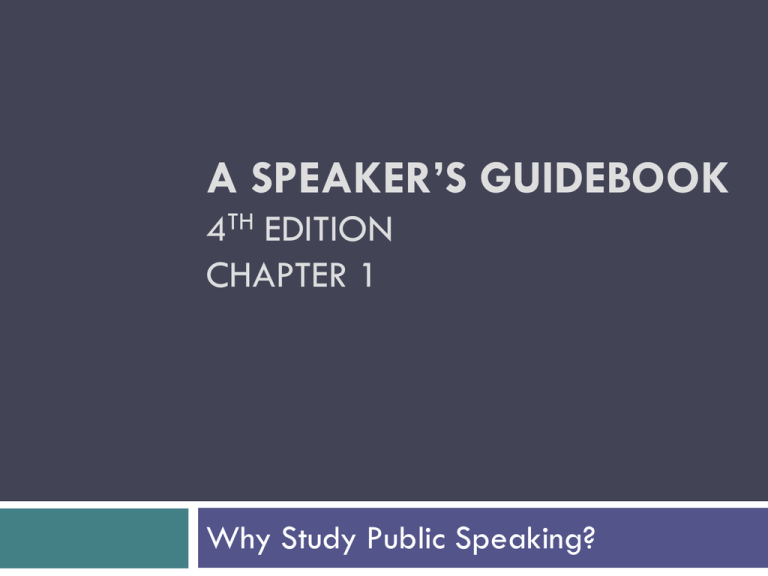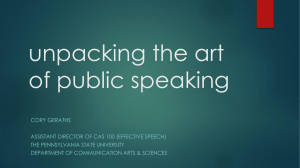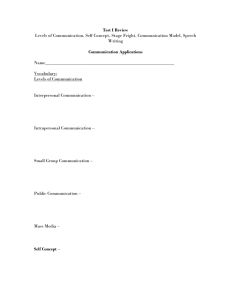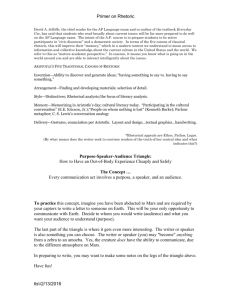chapter1
advertisement

A SPEAKER’S GUIDEBOOK 4TH EDITION CHAPTER 1 Why Study Public Speaking? Study Public Speaking to: A. Advance your professional goals B. Accomplish personal goals C. Enhance your career as a student D. Explore and share values So, this course really is E. Improve critical thinking all about you! If you have an i-clicker, which & listening skills one of these reasons do you consider to be most valuable? In the classroom Oral presentations are common classroom assignments across the disciplines. Organization skills are applicable to most other courses. In the workplace A. Excellent written communication skills B. Effective verbal communication skills C. Constructive interpersonal skills D. Cohesive teamwork skills E. Efficient organization and leadership skills Which one of these communication skills do you believe employers value most? In the community Being an Engaged Citizen Students from the Asian Student Association clean up trash from the local beach. Public issues require citizens to make decisions or take actions. Change occurs when people speak up and work together to solve societal problems. Community Service? Discuss your past experiences. In the community Participating in the Process Use your i-clicker to respond, and then discuss. A. I voted in last election! B. I did not, because I was not eligible to vote. C. I forgot to vote. D. I didn’t want to vote. E. I don’t think my vote matters. In your personal life Small group communication will teach you how to communicate more effectively within your family or with your co-workers. Learning to listen well improves your friendships and romantic relationships. Being articulate about your thoughts and ideas leads to increased satisfaction in your relationships. Comparing public speaking to other types of communication contexts SIMILARITIES You must speak to other people. You must think about your listeners and their needs. You must be understood when you speak. You must be responsible about what you say and how you speak. Comparing public speaking to other types of communication contexts DIFFERENCES You have less opportunity for a response or feedback from your listeners. You are responsible for more of the message content. You must pay closer attention to nonverbal cues and use a formal voice. Successful public speakers Use familiar words and phrases. Use simple sentence structure (S-V-O). Repeat key concepts. Use inclusive language. Use proper grammar. Are more organized with their thoughts. Cultural Sensitivity Speakers recognize the values, behaviors, and artifacts that are important to the cultural group to which they are speaking. A culturally sensitive speaker avoids making ethnocentric remarks and addresses cultural differences with respect. A SPEAKER’S GUIDEBOOK 4TH EDITION CHAPTER 1 The Communication Process Do you agree or disagree? “Anyone who forms a judgment on any point but cannot explain himself clearly might as well have never thought on the subject.” –Pericles, Greek Philosopher Some types of communication Dyadic Communication - Intrapersonal - Interpersonal Public - Speeches - Forums Mass Small Group What type of communication is this child experiencing? May she also be experiencing other types of communication that are not pictured? The Communication Process Communication occurs in a single CONTEXT or SITUATION. The SPEAKER encodes and then transmits a MESSAGE along a CHANNEL to the RECEIVER. The RECEIVER decodes the MESSAGE and sends NONVERBAL FEEDBACK to the SPEAKER. Sometimes NOISE or INTERFERENCE keeps the MESSAGE from reaching the RECEIVER. Obvious Elements of the Communication Process Situation/Context Speaker/Source Message Channel Receiver/Listener/Audience Noise/Interference Verbal Feedback/Nonverbal Feedback Internal Elements of the Communication Process for the Speaker Encoding – speaker thinks of what to say. Audience perspective – speaker considers receiver’s point of view. Shared meaning – mutual understanding of the message between speaker and receiver. Goal – speaker’s purpose. Internal Elements of the Communication Process for the Receiver Decoding – listener interprets what the speaker said or did. Shared meaning – mutual understanding of the message between speaker and receiver. Outcome – effect of message on the receiver. Linear vs. Transactional Communication Linear communication is a one-way message where the receiver does not typically respond to the source. Example: Listening to the news reporter. Transactional communication includes verbal feedback or interruptions. Example: A conversation between friends. Question Which one of the following types of communication is linear? A. Dyadic B. Mass C. Group Question Which one of the following types of communication is usually transactional? A. Dyadic B. Mass C. Group D. Public A SPEAKER’S GUIDEBOOK 4TH EDITION CHAPTER 1 The Canons of Rhetoric History of Rhetoric (The early Greeks) Oratorical skill was required by all. Speeches were persuasive in nature. Self representation existed in court (no lawyers). Public affairs occurred in the agora or marketplace. History of Rhetoric (The Romans) Citizens, as members of a representative democracy, met in a public space, called a forum. The term, public forum, is still used today and refers to both town hall meetings to media outlets. Types of Oratory (The Greeks) Forensic Oratory – legal contexts, such as before a jury Deliberative Oratory – legislative or political contexts Epideictic Oratory – for special ceremonies, such as celebrations and funerals Great Rhetoricians Protagoras Plato Aristotle Cicero Canons of Rhetoric (Aristotle) Invention Arrangement Style Memory Delivery Invention (inventio – Cicero) Adapting the speech information to the audience to make your case (persuasive) Discovering your speech material (informative) INVENTION BREAK: Compile a list of informative and persuasive topics in groups or as a class on which you would like to hear speeches. Arrangement (dispositio – Cicero) Organizing the speech topic Outlining the topic points or claims Designing your visual aid (Disclaimer: The Greeks and Romans did not employ visual aids, such as this PowerPoint slideshow, but relied mostly on oratorical skill). Style (elocutio – Cicero) Meaning: a speaker’s use of language to express ideas. Analogy: Two singers can sing the same words, but that doesn’t mean you’ll like each singer’s style. Memory (memoria – Cicero) The practice of the speech until it can be artfully delivered. Remembering all of the lines of argument to prove your case. Manuscripts used in Extemporaneous speaking are flexible. Forensic speaking requires memorization of manuscripts. Delivery (pronounciatio – Cicero) Includes elements of vocal variety and delivery style Involves nonverbal behavior and gestures used when speaking Question Knowing that you’ll soon be giving a speech, about which one of the canons are you most concerned or nervous? A. Invention B. Arrangement C. Style D. Memory E. Delivery Review the Canons in the Text Invention occurs when you analyze your audience (Ch. 6), select your topic (Ch. 7), and find and use supporting material (Chs. 8-10). Arrangement happens when you organize your thoughts (Chs. 11, 12, & 26), and outline your speech (Ch. 13). Style refers to your use of language (Ch. 16). Memory involves the method of delivery (Ch. 17). Delivery refers to your vocal and nonverbal usage (Chs. 18 & 19). Chapter 1 Key Terms for Review oratory rhetoric agora forum public forum forensic oratory deliberative oratory epideictic oratory canons of rhetoric invention arrangement style memory delivery dyadic communication small group communication mass communication public speaking source encoding receiver decoding feedback audience perspective message channel noise shared meaning rhetorical situation culture ethnocentrism cultural intelligence





